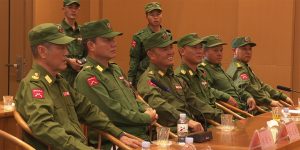China’s government has reportedly brokered an agreement between the Myanmar military and an alliance of armed resistance groups that has made sweeping gains in eastern Myanmar since late last year.
In a Chinese- and Kachin-language statement yesterday, the Three Brotherhood Alliance (3BHA, or Northern Alliance) of resistance groups stated that following a round of China-brokered talks in Kunming, the two sides had agreed to pull their troops back from the frontlines and to ensure that “China’s interests in Myanmar are not harmed.”
The 3BHA, which includes the Myanmar National Democratic Alliance Army (MNDAA), the Ta’ang National Liberation Army (TNLA), and the Arakan Army, launched a broad offensive against junta positions in the region in late October. Operation 1027, as it was known, made rapid gains; it saw MNDAA and TNLA forces seize towns, military outposts, and important border crossings with China, and threaten to push the military out of northern Shan State altogether.
In addition to pledging to pull back their troops and safeguard the Chinese, the potentially most important agreement is the Myanmar military’s agreement formally to recognize the MNDAA as the government of the Kokang special region. The MNDAA took control of the Kokang capital Laukkai in January, after ousting the military-aligned Border Guard Force that had run the region for the past 15 years in collusion with a handful of Chinese crime families. The agreement formalizes the MNDAA’s reversal of the Myanmar military offensive that drove it out of the region in 2009.
Other elements of the agreement involved the reopening of the overland trade between Myanmar and China, after a prolonged interruption due to the fighting that followed Operation 1027. According to the agreement, the MNDAA and the military have agreed to a 70-30 split of the proceeds from customs at the Chinshwehaw border gate, which fell in the early weeks of Operation 1027.
The two sides have not yet agreed on how to divide up the revenue from the Muse-Ruili border crossing, which handles the lion’s share of the China-Myanmar border trade. Muse remains under military control, but surrounded by TNLA forces. According to the agreement, “there are still many clauses and details for specific implementation that need to be negotiated and resolved in the fifth round of negotiations in April.”
As Jason Tower of the United States Institute of Peace noted on X (formerly Twitter), the agreement “is basically aimed at facilitating trade between China and Myanmar across both 3BHA and junta held territories.” Beyond that, it is unclear whether or how long the various agreements will hold.
China’s motivation for brokering the agreement is obvious, and Beijing has been seeking a resumption of the border trade since January. But there are also good reasons for both the 3BHA and the Myanmar military to play ball, at least for now: neither can afford to alienate China or ignore its wishes, and both need time to consolidate their respective positions. The MNDAA is occupied with reestablishing its administrative organs in Kokang. On February 29, for instance, the group announced that it would begin collecting taxes from local businesses as of April 1.
The Myanmar military’s formal recognition of the MNDAA’s position in Kokang is a pragmatic recognition of the new reality on the ground; given its recent losses, and ongoing pressure from the Arakan Army in Rakhine State, the army high command is presumably hoping that despite its recent bad blood with the MNDAA, that it can come to an understanding with the group and keep it within the “legal fold.”
The interesting related question concerns the MNDAA’s motivations, and the nature of its relationship to the broader movement seeking the overthrow of the military administration that seized power in February 2021. In announcing the offensive on October 27, the MNDAA and its allies stated that they were “dedicated to eradicating the oppressive military dictatorship.” The group has since been embraced widely as part of the movement aiming to create an inclusive federal democracy in its place.
As I have mentioned before, however, the group’s well-attested past involvement in both heroin and methamphetamine production, and its mercenary relationship with the military in the two decades to 2009, suggests reasons for caution.
Since 2009, the MNDAA’s overriding goal has been to take back control of Kokang and to seek revenge on those who betrayed it to the Myanmar military. Now that it has achieved this, it will soon become clear how committed it is to the wider cause of bringing down the military junta and establishing a federal democracy in Myanmar.

































